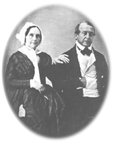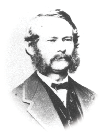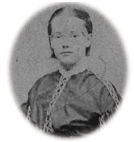
|
|
"I suspect that Stephen Foster owed something to this well, this mystery, this sorrow. 'My Old Kentucky Home' makes you think so, at any rate. Something there suggests close acquaintance with my people..." - W. C. Handy, Father of the Blues (1941) "Well looka here / we are far from home-yeah, man!" - Louis Armstrong, "Old Folks At Home" (1939) Biography
Foster's life has become part of American legend. One thread of the tale is that he detested school and so was poorly educated. In truth, as a young boy Stephen evinced more interest in music than in other subjects. But as the child of a middle-class family in an era before tax-supported public education, he variously was privately tutored, then schooled at private academies in Pittsburgh and in north-central Pennsylvania. He expressed a distaste for rote learning and recitation, but was an avid reader and eventually became a literate, well-educated person by the standards of his day. He was musically literate as well; he probably received some formal musical training from a German immigrant, As a teen, Foster enjoyed the friendship of young men and women from some of Pittsburgh's most prosperous and respectable families. Stephen, his brother Morrison, and his close friend, Charles Shiras, were all members of an all-male secret club called Knights of the S.T. [probably Square Table] that met twice weekly at the Fosters' home. One of their principal activities was singing, with Stephen acting first as song leader and then composer. Some of his earliest songs--perhaps including "Oh! Susanna"--were composed for the group. His first published song, "Open Thy Lattice Love", appeared from a Philadelphia music publisher when Stephen was only 18.
Another thread in the mythic fabric is that Foster dashed off perfect masterpieces in a flash of inspiration, songs expressing the sentiment of American ante-bellum South. Yet, aside from these absences, visits to the family in Ohio, and until he went to New York for good in 1860, Stephen spent much of his life in Pittsburgh where he worked consistently at his songwriting, keeping a thick sketchbook to draft ideas for song lyrics and melodies. As a professional songwriter of unparalleled skill and technique--not an untutored musical genius--he had made it his business to study the various music and poetic styles circulating in the immigrant populations of the new United States. His intention was to write the people's music, using images and a musical vocabulary that would be widely understood by all groups. Foster worked very hard at writing, sometimes taking several months to craft and polish the words, melody, and accompaniment of a song before sending it off to a publisher. His sketchbook shows that he often labored over the smallest details, the right prepositions, even where to include or remove a comma from his lyrics. Rather than writing nostalgically for an old South (it was, after all, the present day for him), or trivializing the hardships of slavery, Foster sought to humanize the characters in his songs, to have them care for one another, and to convey a sense that all people--regardless of their ethnic identities or social and economic class--share the same longings and needs for family and home. He instructed white performers of his songs not to mock slaves but to get their audiences to feel compassion for them. In his own words, he sought to "build up taste...among refined people by making words suitable to their taste, instead of the trashy and really offensive words which belong to some songs of that order." Stephen Foster is understood by some scholars as having reformed sentimental songs in black-face minstrelsy, then the most pervasive and powerful force in American popular culture.
It is possible that the sense of compassion reflected in some of his songs was aided and encouraged by his boyhood friend and artistic collaborator [ardent abolitionist] Charles Shiras.” Pittsburgh was a center for abolitionist activities in Pennsylvania, and Shiras was a leader of the movement. Inspired by local appearances by William Lloyd Garrison and Frederick Douglass, Shiras launched a crusading abolitionist newspaper, and subsequently published a volume of anti-slavery and anti-capitalist verse. He and Stephen wrote at least one song together, and a stage work that was performed but never published and is now lost. Though another thread of the myth romantically portrays Stephen Foster as such a pure artist that he had no business sense and squandered all his wealth, in fact he kept his own account books, documenting down to the penny how much his publishers paid him for each song, and he calculated his probable future earnings on each piece. His contracts were written out in his own hand; they are the earliest ones we know of between American music publishers and individual songwriters. In reality, Foster was not an idle street musician without direction in his life, he was a pioneer. There was no music business as we know it (sound recording was not invented until 13 years after his death; radio, 66 years); no system of publishers and agents vying to sell new songs; no "performing rights" fees from restaurant singers or minstrels or theater musicians or concert recitalists; no way of earning money except through a 5-to-10 percent royalty on sheet music sales of his own editions by his original publisher, or though the outright purchase of a song by a publisher. There was no way to know whether or not he was being paid for all the copies his publisher sold; there were no attorneys specializing in authors' rights. Copyright law protected far less than it does today: Foster earned nothing for other arrangers' settings of his songs, broadside printings of his lyrics, or for other publishers' editions of his music. In today's music industry he would be worth millions of dollars a year; on January 13, 1864, he died at age 37 with 38 cents in his pocket and a penciled scrap of paper that read, "dear friends and gentle hearts." His brother Henry described the accident in the New York theater-district hotel that led to his death: confined to bed for days by a persistent fever, Stephen tried to call a chambermaid, but collapsed, falling against the washbasin next to his bed and shattering it, which gouged his head. It took three hours to get him to the hospital, and in that era before transfusions and antibiotics, he succumbed after three days. |
The Center for American Music is part of the University of Pittsburgh Library System.
Copyright © 2010 Center for American Music. All content is protected by copyright and may not be copied and/or used for any purpose without written consent.
Last updated June 6, 2012
 Stephen Collins Foster, the ninth of William B. and Eliza T. Foster's ten children (plus a son fathered by William before the marriage and later raised as their oldest child), was born July 4, 1826, in a white cottage high on the hillside above the Allegheny River in Lawrenceville, east of Pittsburgh. The tenth child died as an infant, leaving Stephen as the "baby" of the family to be indulged by older brothers and sisters.
Stephen Collins Foster, the ninth of William B. and Eliza T. Foster's ten children (plus a son fathered by William before the marriage and later raised as their oldest child), was born July 4, 1826, in a white cottage high on the hillside above the Allegheny River in Lawrenceville, east of Pittsburgh. The tenth child died as an infant, leaving Stephen as the "baby" of the family to be indulged by older brothers and sisters. Henry Kleber, an accomplished and versatile musician who eventually exerted a major influence on Pittsburgh's musical life as a performer, composer, music merchant, impresario, and teacher.
Henry Kleber, an accomplished and versatile musician who eventually exerted a major influence on Pittsburgh's musical life as a performer, composer, music merchant, impresario, and teacher.  At age 20, Stephen went to work as a bookkeeper for his brother Dunning's steamship firm in Cincinnati. There he also sold some of his songs and piano pieces to a local music publisher and had his first big hit with "Oh! Susanna." In 1850, already with 12 compositions in print, the 24-year-old Stephen returned to Pittsburgh, married 20-year-old Jane Denny MacDowell, and launched his career as a professional songwriter. Their daughter Marion Marion Foster was born the following year. In 1852 the couple took a delayed honeymoon, a month-long steamship ride to New Orleans with friends, the only trip Stephen ever made to the deep south (he had visited Ohio River towns in Kentucky as a child). In 1853, he went to New York to be near his publishers; Jane joined him in Hoboken, N.J., sometime in 1854. They returned to Pittsburgh later that year, living first in the family home and then a series of boarding houses after both of his parents died in 1855.
At age 20, Stephen went to work as a bookkeeper for his brother Dunning's steamship firm in Cincinnati. There he also sold some of his songs and piano pieces to a local music publisher and had his first big hit with "Oh! Susanna." In 1850, already with 12 compositions in print, the 24-year-old Stephen returned to Pittsburgh, married 20-year-old Jane Denny MacDowell, and launched his career as a professional songwriter. Their daughter Marion Marion Foster was born the following year. In 1852 the couple took a delayed honeymoon, a month-long steamship ride to New Orleans with friends, the only trip Stephen ever made to the deep south (he had visited Ohio River towns in Kentucky as a child). In 1853, he went to New York to be near his publishers; Jane joined him in Hoboken, N.J., sometime in 1854. They returned to Pittsburgh later that year, living first in the family home and then a series of boarding houses after both of his parents died in 1855.